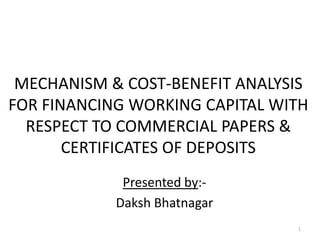Commercial Papers and Certificate of Deposits
- 1. MECHANISM & COST-BENEFIT ANALYSIS FOR FINANCING WORKING CAPITAL WITH RESPECT TO COMMERCIAL PAPERS & CERTIFICATES OF DEPOSITS Presented by:Daksh Bhatnagar 1
- 2. SOURCES OF FINANCING WORKING CAPITAL SHORT TERM SOURCES Sources of Financing W.C Long Term Sources Short term sources 1. Trade Credit 2. Accrued Expenses & Deferred Income 3. Bank Credit 4. Inter-corporate deposits 5. Advances from Customers 6. Internal sources 7. Some new & innovative sources (Non-bank) a. Commercial Papers b. Convertible Debenture c. Factoring 2
- 3. COMMERCIAL PAPER (CP) ? Debt instrument issued by corporate houses for raising short term financial resources from the money market are called Commercial Papers ? Borrowers along with interest costs a placement fee to the dealer for arranging the sale of the issue ? Annual financing cost depends upon:a) maturity date of the issue b) prevailing short term interest rates ? Purchasers of CP can be:a) b) c) d) Corporations with excess funds to invest Banks Insurance Companies; and Other Types of Financial Institutions 3
- 4. FEATURES OF COMMERCIAL PAPER ? Nature 1. 2. 3. 4. Unsecured Debt of corporate Redeemable at par to the holder of maturity Min. Tangible net worth of Rs. 4 crores required to issue CPs No prior approval from RBI required to issue CPs ? Market – Public sector as well as Private sector enterprises ? Rating – CPs must be graded by org. issuing them. ? Interest rates – varies greatly. Factors of such variations are credit rating of the instrument, economic phase, prevailing rate of interest in CP market, call rates etc. 4
- 5. FEATURES OF COMMERCIAL PAPER ? Marketability – influenced by the rate prevailing in the call money market and the foreign exchange market ? Maturity – 3 to 30 days. Reduced to 15 days from April 25, 1998. 5
- 6. MECHANISM OF COMMERCIAL PAPER Credit Rating Agency Obtain Credit rating for C.P. issue Issue CP at discount Issuing Company Draw Down Book Limits Lender Bank Investor Bank/Company Redeem CP At Maturity
- 7. ADVANTAGES OF COMMERCIAL PAPERS ? Large corporations go for Commercial Papers because the interest rates of CP are below the Prime Lending Rate ? There is no floating charge or preferential rights on the assets 7
- 8. DEMERITS OF COMMERCIAL PAPERS ? Not always a reliable source of funds ? Sold on a discount basis – Firm receives less amount from the investor and pays full amount at the time of maturity. ? Unnecessary burden – If the firm doesn’t want any funds from the CP issue, it will still pay the interest ? Only big and financially sound companies can take the advantage of CPs 8
- 9. SATELLITE DEALERS (SDs) ? Dealers entitled with the RBI to deal in the Govt. Securities market are called SATELLITE DEALERS ? From June 17, 1998, SDs were allowed to issue CPs with the approval from RBI ? Following conditions must be satisfied by a SD in order to deal in CPs:1. Rating – Min. Credit rating must be obtained from a credit rating agency 2. Maturity of CP – 15 days to 1 year from the date of issue 3. Target market – Individuals, banks, companies 4. Limits of Issue – a) b) Multiples of Rs. 5 lakhs, Issue Amount to be raised within a period of 2 weeks from the date of approval by RBI or maybe issued on a single day or in parts on different days 5. Nature – Shall be in the form of Usance promissory note, 9
- 10. CERTIFICATE OF DEPOSITS (CDs) ? A marketable document of title to a time deposit for a specified period may be referred to as a ‘Certificate of Deposit’ ? It takes the form of a receipt given by a bank or any other institutions for funds deposited with it by the depositor 10
- 11. FEATURES ? Negotiable Instruments – Negotiable term deposit certificates issued by commercial banks/ financial institutions at discount to face value at market rates. Negotiable Instrument Act governs CDs ? Maturity – 15 days to 1 year ? Nature – in the form of usance promissory notes ? Ideal Source – liabilities of commercial banks/ Financial Institutions 11
- 12. THE LAUNCH & MECHANISM ? RBI launched CDs w.e.f March 27, 1989. ? Scheduled Commercial banks (except RRBs) and all-India Financial Institutions, namely, IDBI, IFCI, ICICI, SIDBI, IRBI & EXIM bank can issue CDs MECHANISM ? Individuals, associations, companies, trust funds, NRIs etc. can subscribe for CDs ? Freely transferable by endorsement and delivery after the initial lock-in period of 15 days ? Stamp duty is payable on CDs ? Min. Size of a CD is Rs 5 lakhs and min. Size of an issue to a single investor is Rs. 25 lakhs ? Banks must submit fortnightly report on their CDs to RBI under the Section 42 of RBI Act, 1935. ? Banks cannot buyback their own CDs before maturity date 12
- 13. ADVANTAGE OF CDs ? Safe + Liquid + Attractive in returns for both investors as well as scheduled commercial banks ? Provides the opportunity for the bulk mobilization of resources as part of effective fund management 13
- 14. DISAVANTAGE OF CDs ? Holding of CDs till maturity date spearheads to ineffective secondary market ? Banks cannot grant loans against CDs 14
- 15. CITATIONS ? FINANCIAL MARKETS AND INSTITUTIONS (3rd Edition) – Dr. S Gurusamy ? WORKING CAPITAL MANAGEMENT (10th Revised Edition) - V.K Bhalla 15
- 16. THANK YOU 16
















